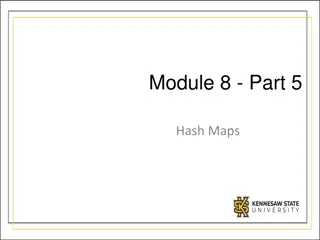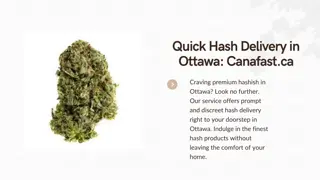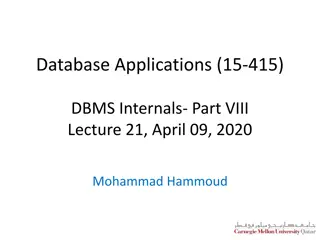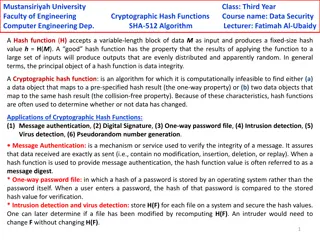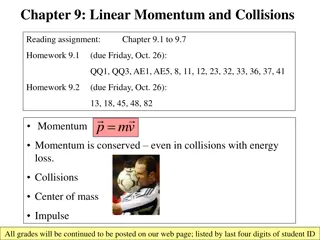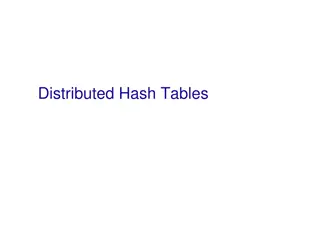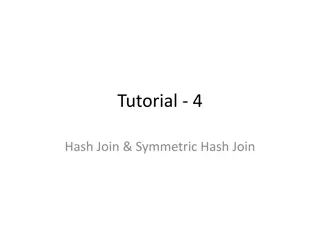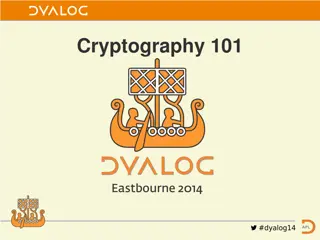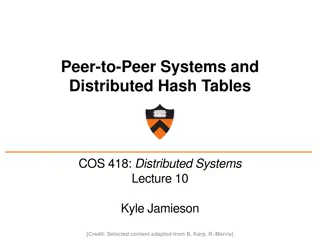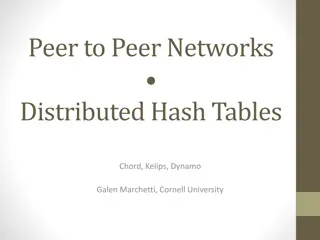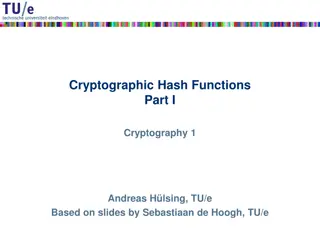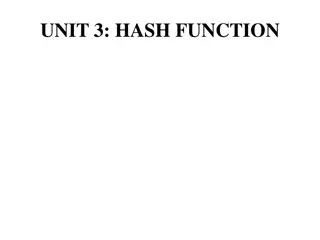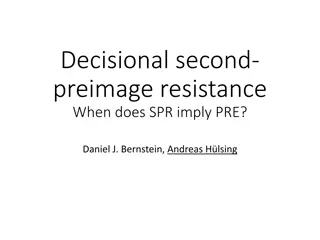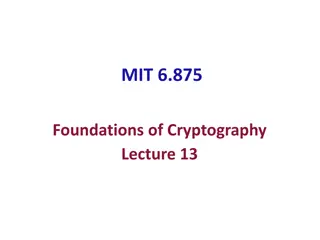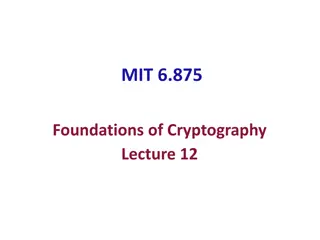Understanding Hash Tables and Handling Collisions
This content covers the concepts of hash tables, handling collisions, and efficient implementation of dictionary operations. It explores methods like direct-access tables, converting keys to non-negative integers, and using functions to work with non-integer keys. The discussion includes approaches for storing different data types like strings, images, and videos in memory as integers for hashing purposes.
Download Presentation

Please find below an Image/Link to download the presentation.
The content on the website is provided AS IS for your information and personal use only. It may not be sold, licensed, or shared on other websites without obtaining consent from the author. Download presentation by click this link. If you encounter any issues during the download, it is possible that the publisher has removed the file from their server.
E N D
Presentation Transcript
CSE 373: Data Structures and Algorithms Hash Tables: Handling Collisions Autumn 2018 Shrirang (Shri) Mare shri@cs.washington.edu Thanks to Kasey Champion, Ben Jones, Adam Blank, Michael Lee, Evan McCarty, Robbie Weber, Whitaker Brand, Zora Fung, Stuart Reges, Justin Hsia, Ruth Anderson, and many others for sample slides and materials ...
Announcements - HW3 due Friday Noon - Office hours for next week have changed. Please see the calendar for the correct info - We made a mistake in a comment in HW4. We ll push a commit to your repo to correct that. (So expect one more git commit from us.) CSE 373 AU 18 SHRI MARE 2
Today - Review Hashing - Separate Chaining - Open addressing with linear probing - Open addressing with quadratic probing CSE 373 AU 18 SHRI MARE 3
Problem (Motivation for hashing) How can we implement a dictionary such that dictionary operations are efficient? Idea 1: Idea 1: Create a giant array and use keys as indices. (This approach is called direct-access table or direct-access map) Two main problems: Two main problems: 1. Can only work with integer keys? 2. Too much wasted space Idea 2: Idea 2: What if we (a) convert any type of key into a non-negative integer key (b) map the entire key space into a small set of keys (so we can use just the right size array) CSE 373 AU 18 SHRI MARE 4
Solution to problem 1: Can only work with integer keys? Idea: Idea: Use functions that convert a non-integer key into a non-negative integer key CSE 373 AU 18 SHRI MARE 5
Solution to problem 1: Can only work with integer keys? Idea: Idea: Use functions that convert a non-integer key into a non-negative integer key - Everything is stored as bits in memory and can be represented as an integer. - But the representation can be much simpler (nothing to do with memory). - For example (just for illustration; this is not how strings, images, and videos are hashed in practice): - Strings can be represented with number of characters in the string, ascii value of the first char, last char - Image can be represented with resolution, size of image, value of the 5th pixel in the image, 100th pixel - Similarly, video can be represented resolution, size, frame rate, size of the 10th frame CSE 373 AU 18 SHRI MARE 6
Solution to problem 1: Can only work with integer keys? Idea: Idea: Use functions that convert a non-integer key into a non-negative integer key - Everything is stored as bits in memory and can be represented as an integer. - But the representation can be much simpler (nothing to do with memory). - For example (just for illustration; this is not how strings, images, and videos are hashed in practice): - Strings can be represented with number of characters in the string, ascii value of the first char, last char - Image can be represented with resolution, size of image, value of the 5th pixel in the image, 100th pixel - Similarly, video can be represented resolution, size, frame rate, size of the 10th frame Question: Question: What are some good strategies to pick a hash function? (This is important) 1. Quick: Computing hash should be quick (constant time). 2. Deterministic: Hash value of a key should be the same hash table. 3. Random: A good hash function should distribute the keys uniformly into the slots in the table. CSE 373 AU 18 SHRI MARE 7
Solution to problem 2: Too much wasted space Idea: Idea: Map the entire key space into a small set of keys (so we can use just the right sized array) CSE 373 AU 18 SHRI MARE 8
Solution to problem 2: Too much wasted space Idea: Idea: Map the entire key space into a small set of keys (so we can use just the right sized array) CSE 373 AU 18 SHRI MARE 9
Review: The modulus (mod) operation The modulus (mod) operation The modulus (or mod) operation gives the remainder of a division of one number by another. Written as x mod n or x % n. Examples: 1 % 10 = 1 11 % 10 = 1 10 % 10 = 0 5746 % 10 = 6 71 % 7 = 1 For more review/practice, check out https://www.khanacademy.org/computing/computer-science/cryptography/modarithmetic/a/what-is-modular-arithmetic 10
Review: The modulus (mod) operation The modulus (mod) operation The modulus (or mod) operation gives the remainder of a division of one number by another. Written as x mod n or x % n. Examples: Common applications of the mod operation: - finding last digit ( % 10) - whether a number is odd/even (% 2) - wrap around behavior (% wrap limit) 1 % 10 = 1 11 % 10 = 1 10 % 10 = 0 5746 % 10 = 6 71 % 7 = 1 The application we are interested in is the wrap around behavior. It lets us map any large integer into an index in our array of size m (using % m) For more review/practice, check out https://www.khanacademy.org/computing/computer-science/cryptography/modarithmetic/a/what-is-modular-arithmetic 11
Implementing a simple hash table (assume no collisions) public V get(int key) { return this.array[key].value; } public void put(int key, V value) { this.array[key] = value; } public void remove(int key) { this.array[key] = null; } CSE 373 AU 18 SHRI MARE 12
Implementing a simple hash table (assume no collisions) public V get(int key) { key = getHash(key) return this.array[key].value; } public int getHash(int a) { return a % this.array.length; } public void put(int key, V value) { key = getHash(key) this.array[key] = value; } public void remove(int key) { key = getHash(key) this.array[key] = null; } CSE 373 AU 18 SHRI MARE 13
Our simple hash table: insert (1000) CSE 373 AU 18 SHRI MARE 14
Our simple hash table: insert (1000) Hash collision Some other value exists in slot at index 0 CSE 373 AU 18 SHRI MARE 15
Hash collision What is a hash collision? It s a case when two different keys have the same hash value. Mathematically, h(k1) = h(k2) when k1 k2 CSE 373 AU 18 SHRI MARE 16
Hash collision What is a hash collision? It s a case when two different keys have the same hash value. Mathematically, h(k1) = h(k2) when k1 k2 Why is this a problem? - We put keys in slots determined by the hash function. That is, we put k1 at index h(k1), - A collision means the natural choice slot is taken - We cannot replace k1 with k2 (because the keys are different) - So the problem is where do we put k2? CSE 373 AU 18 SHRI MARE 17
Strategies to handle hash collision CSE 373 AU 18 SHRI MARE 18
Strategies to handle hash collision There are multiple strategies. In this class, we ll cover the following three: 1. Separate chaining 2. Open addressing - Linear probing - Quadratic probing 3. Double hashing CSE 373 AU 18 SHRI MARE 19
Separate chaining - Separate chaining is a collision resolution strategy where collisions are resolved by storing all colliding keys in the same slot (using linked list or some other data structure) - Each slot stores a pointer to another data structure (usually a linked list or an AVL tree) put(21, value21) put(44, value44) Note: For simplicity, the table shows only keys, but in each slot/node both, key and value, are stored. CSE 373 AU 18 SHRI MARE 20
Separate chaining - Separate chaining is a collision resolution strategy where collisions are resolved by storing all colliding keys in the same slot (using linked list or some other data structure) - Each slot stores a pointer to another data structure (usually a linked list or an AVL tree) put(21, value21) put(44, value44) Note: For simplicity, the table shows only keys, but in each slot/node both, key and value, are stored. CSE 373 AU 18 SHRI MARE 21
Separate chaining: Running Times What are the running times for: insert Best: Worst: find Best: Worst: delete Best: Worst: CSE 332 SU 18 ROBBIE WEBER
Separate chaining: Running Times What are the running times for: insert Best: ?(1) Worst: ?(?)(if insertions are always at the end of the linked list) find Best: ?(1) Worst: ?(?) delete Best: ?(1) Worst: ?(?) CSE 332 SU 18 ROBBIE WEBER
Load Factor Load Factor ( ) Ratio of number of entries in the table to table size. If n is the total number of (key, value) pairs stored in the table and c is capacity of the table (i.e., array), Load factor CSE 373 AU 18 SHRI MARE 24
Worksheet Q1-Q3 CSE 373 AU 18 SHRI MARE 25
Worksheet Q3 CSE 373 AU 18 SHRI MARE 26
Open Addressing - Open addressing is a collision resolution strategy where collisions are resolved by storing the colliding key in a different location when the natural choice is full. CSE 373 AU 18 SHRI MARE 27
Open Addressing - Open addressing is a collision resolution strategy where collisions are resolved by storing the colliding key in a different location when the natural choice is full. put(21, value21) Note: For simplicity, the table shows only keys, but in each slot both, key and value, are stored. CSE 373 AU 18 SHRI MARE 28
Open Addressing: Linear probing - Open addressing is a collision resolution strategy where collisions are resolved by storing the colliding key in a different location when the natural choice is full. Linear probing Index = hash(k) + 0 (if occupied, try next i) = hash(k) + 1 (if occupied, try next i) = hash(k) + 2 (if occupied, try next i) = .. = .. = .. put(21, value21) Note: For simplicity, the table shows only keys, but in each slot both, key and value, are stored. CSE 373 AU 18 SHRI MARE 29
Open Addressing: Quadratic probing - Open addressing is a collision resolution strategy where collisions are resolved by storing the colliding key in a different location when the natural choice is full. Quadratic probing Index = hash(k) + 0 (if occupied, try next i^2) = hash(k) + 1^2 (if occupied, try next i^2) = hash(k) + 2^2 (if occupied, try next i^2) = hash(k) + 3^2 (if occupied, try next i^2) = .. = .. put(21, value21) Note: For simplicity, the table shows only keys, but in each slot both, key and value, are stored. CSE 373 AU 18 SHRI MARE 30
Worksheet Q4 31
Worksheet Q5 CSE 373 AU 18 SHRI MARE 32


